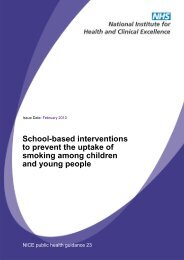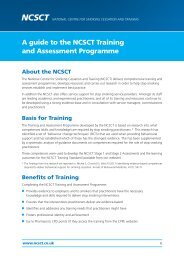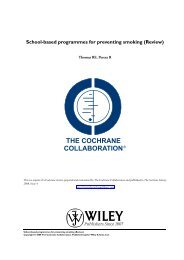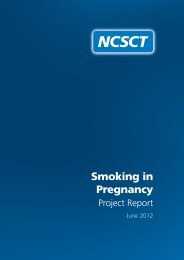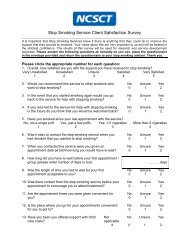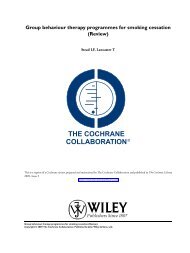Smoking and mental health - NCSCT
Smoking and mental health - NCSCT
Smoking and mental health - NCSCT
Create successful ePaper yourself
Turn your PDF publications into a flip-book with our unique Google optimized e-Paper software.
Mental disorders 1<br />
1.3 Common <strong>mental</strong> disorders<br />
Depression <strong>and</strong> anxiety are common <strong>mental</strong> disorders, with a lifetime<br />
prevalence of at least 25%. 4 Depression, defined as a disorder if symptoms have<br />
been present for at least 2 weeks, is the most common; symptoms include<br />
feeling sad or irritable most of the time, loss of pleasure or interest in things<br />
that used to be enjoyed, significant loss or gain of weight that is unrelated to<br />
physical illness or pregnancy, difficulty sleeping or over-sleeping, feeling restless<br />
or slowed down, fatigue, feelings of worthlessness or excessive guilt, <strong>and</strong><br />
difficulties concentrating, remembering or making decisions. There may be<br />
thoughts of self-harm or suicide. Depressive disorders can also be associated<br />
with prominent symptoms of anxiety. Risk factors for depression include<br />
younger age, female gender, low educational achievement, a previous history of<br />
depression, a family history of depression, childhood maltreatment <strong>and</strong><br />
adulthood domestic violence. 16–18 Less commonly, severe depression occurs<br />
with psychotic symptoms <strong>and</strong> is then classified as an affective (mood-related)<br />
psychotic disorder (see below).<br />
Anxiety disorders include phobias such as agoraphobia (fear <strong>and</strong> avoidance of<br />
crowds, public places or travelling away from home), social phobia (marked fear<br />
of being the focus of attention, fear of behaving in a way that will be<br />
embarrassing, <strong>and</strong> marked avoidance of situations in which there is fear of<br />
behaving in an embarrassing way), panic disorder (recurrent panic attacks) <strong>and</strong><br />
generalised anxiety disorder (at least 6 months of prominent tension, worry <strong>and</strong><br />
feelings of apprehension about everyday events <strong>and</strong> problems, with anxiety<br />
symptoms). Anxiety symptoms include autonomic arousal symptoms (eg<br />
palpitations, sweating, trembling, dry mouth), difficulty in breathing, <strong>and</strong> fear of<br />
dying or losing control. 1<br />
The 2007 Adult Psychiatric Morbidity Survey (APMS) in Engl<strong>and</strong> found that<br />
women were more likely than men to have a common <strong>mental</strong> disorder (19.7%<br />
<strong>and</strong> 12.5% respectively), <strong>and</strong> that this applied for all disorder categories except<br />
panic <strong>and</strong> obsessive–compulsive disorder. 4 Depression <strong>and</strong> anxiety tend to be<br />
recurrent or persistent in most patients. 19<br />
1.4 Other non-psychotic disorders<br />
1.4.1 Obsessive–compulsive disorder<br />
Obsessive–compulsive disorder (OCD) is characterised by the presence of<br />
obsessions (unwanted intrusive thoughts, images or urges, which repeatedly enter<br />
the person’s mind) or compulsions (repetitive behaviours or <strong>mental</strong> acts that the<br />
person feels driven to perform, such as checking that taps are switched off, or<br />
repeatedly cleaning), <strong>and</strong> commonly both. OCD occurs in around 1% of<br />
people, 20 with similar rates in men <strong>and</strong> women, <strong>and</strong> may follow an acute,<br />
© Royal College of Physicians 2013 3




